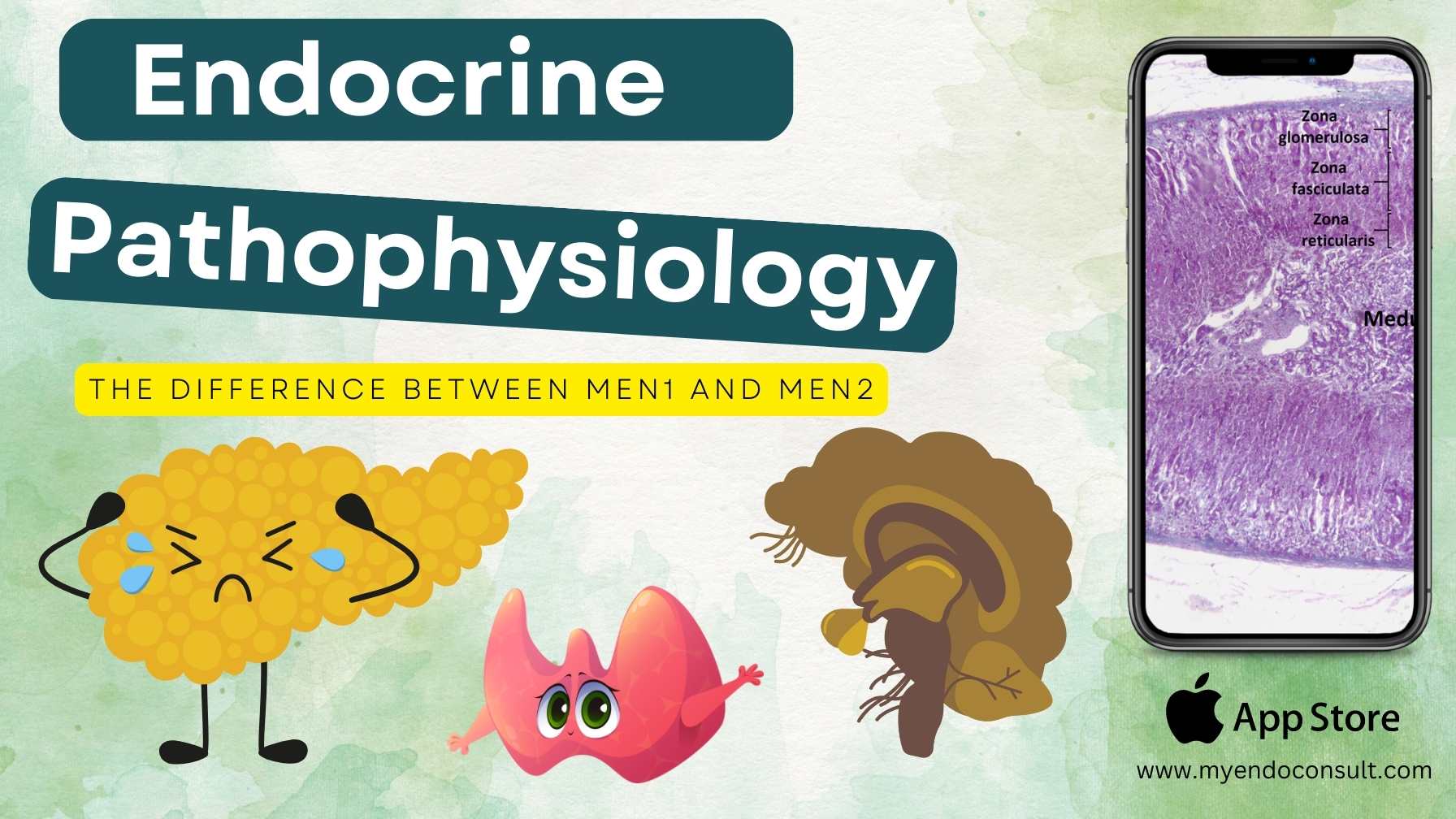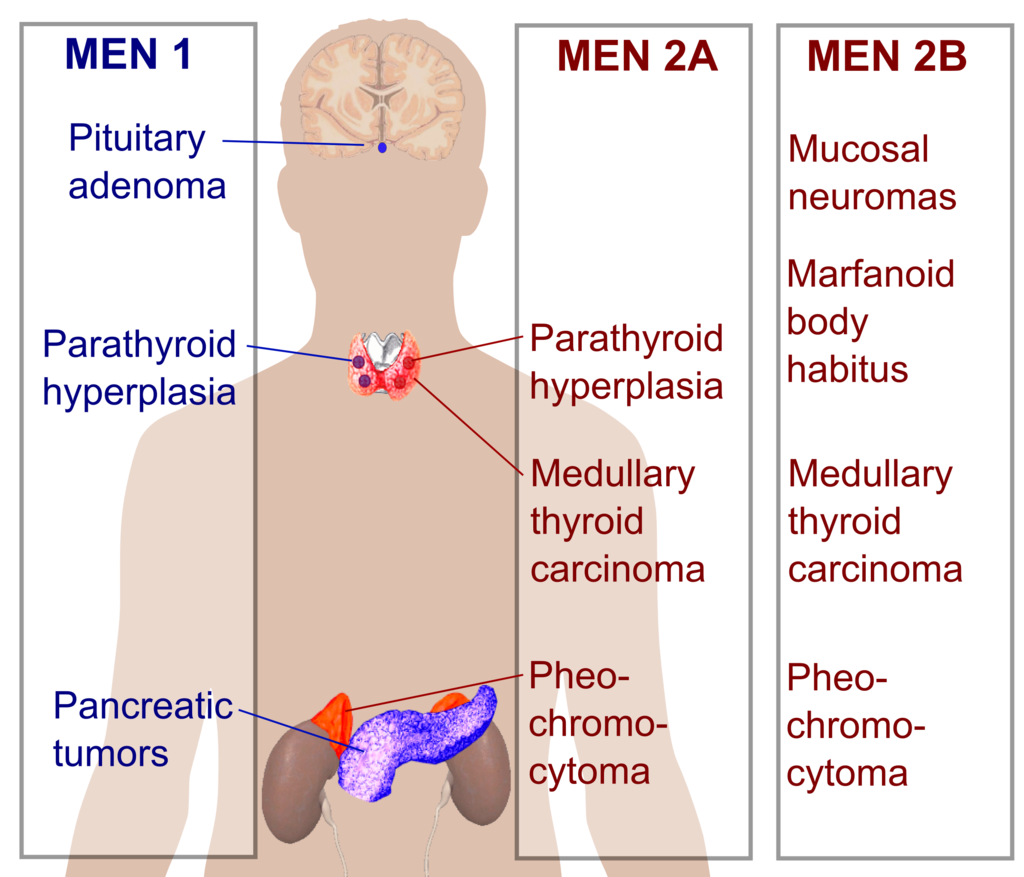
Multiple endocrine neoplasia 1 and 2 (MEN1 and MEN2) are rare disorders of the endocrine system. A comparison of these syndromes and approach to management.
Multiple Endocrine Neoplasia
MEN syndrome describes a group of autosomal dominant inherited disorders characterized by the presence of tumors involving ≥2 endocrine organs, which occur in either a synchronous or metachronous fashion.
What is Multiple Endocrine Neoplasia 1 (MEN1)?
MEN1 is a tumor suppressor gene which is located on chromosome 11q13. This gene consists of exon sequences which encodes a 610 amino acid protein known as Menin. Menin is responsible for various intracellular processes including the regulation of transcription, genome stability, cell division, and proliferation.
An error in inheritance i.e., a germ-line mutation predisposes involved tissues to tumor formation. First-degree relatives of an affected individual who comes to medical attention (proband) have a 50% chance of developing MEN1.
The usual endocrine glands involved in MEN1 include parathyroid hyperplasia (or adenoma), pituitary adenomas, pancreatic neuroendocrine tumors.
This can easily be remembered by the mnemonic PPP (Parathyroid, Pituitary and Pancreas). See Table 1 for additional features of this syndrome.
When should you consider screening for MEN1 syndrome? (Any)
- ≥2 MEN1-associated endocrine tumors (parathyroid, pancreatic, and pituitary tumor)
- All asymptomatic first-degree relatives of an individual with MEN1 mutation
- ≥2 MEN1-associated endocrine tumors that are not part of classical triad of parathyroid, pancreatic, or pituitary tumor
- PHPT <30 years of age
- Multiglandular parathyroid disease
- Gastrinoma
- Multiple pancreatic neuroendocrine tumor
- PHPT <30 years of age
- Multiglandular parathyroid disease
- Multiple ulcerations at unusual sites
A patient with suspected MEN1 syndrome presents with primary hyperparathyroidism. Which additional tests are required?
- Serum gastrin
- Fasting plasma glucose
- Fasting insulin and C-peptide
- Serum prolactin
- Serum Chromogranin A.
What is Multiple Endocrine Neoplasia 2 (MEN2)?
MEN2 is an autosomal dominant inherited disorder characterized by multiple endocrine organ involvement principally of neural crest origin.
Mutation of the REarranged during Transfection (RET) proto-oncogene ( expressed by cells of the neural crest, branchial arch, and urogenital system) is responsible for MEN2. The RET gene located on located on chromosome 10q11.2 and encodes the receptors of the tyrosine kinase family. Indeed, constitutive activation of this receptor and consequent downstream signaling result in unrestricted cell growth and proliferation.
Gain-of-function mutations of RET proto-oncogene result in tumorigenesis in these organs. Thus patients with MEN2A, MEN2B and familial medullary thyroid cancer have underlying germ-line mutations involving the RET proto-oncogene.
See table 1 for the features of MEN2 A and B.
Should patients with presumed sporadic Medullary thyroid cancer undergo genetic testing?
Yes, approximately 50 % of patients with sporadic MTC have somatic RET mutations
Comparison of MEN1 and MEN2
| MEN syndrome | Primary Endocrine Glands | Additional Features |
| MEN1 | • Parathyroid hyperplasia • Pituitary Adenoma • Pancreatic neuroendocrine tumors • Adrenal (Nonfunctional) adrenal adenomas or hyperplasia • Nodular thyroid disease | Gastric carcinoids Lipomas Collagenomas Angiofibromas Meningiomas |
| MEN2A | • Parathyroid hyperplasia • Medullary thyroid carcinoma • Pheochromocytomas | Hirschsprung disease Cutaneous lichen amyloidosis |
| MEN2B | • Medullary thyroid carcinoma • Pheochromocytomas • Marfanoid habitus/Mucosal Neuromas | Slipped upper capital femoral epiphysis |
Summary of MEN1 and MEN2

Question
What is Multiple Endocrine Neoplasia (MEON)?
These are disorders which are associated with multiple endocrine as well as non-endocrine neoplasia
- Carney’s complex
- Von Hippel–Lindau disease
- Neurofibromatosis type 1
Selected References
- Thakker RV. Multiple endocrine neoplasia type 1 (MEN1). Best Pract Res Clin Endocrinol Metab. 2010 Jun;24(3):355-70.
- Giri D, McKay V, Weber A, Blair JC. Multiple endocrine neoplasia syndromes 1 and 2: manifestations and management in childhood and adolescence. Arch Dis Child. 2015 Oct;100(10):994-9.
Infographic Courtesy
Mikael Häggström, CC0, via Wikimedia Commons
Kindly Let Us Know If This Was helpful? Thank You!


